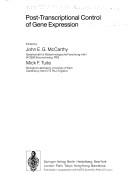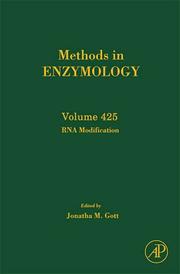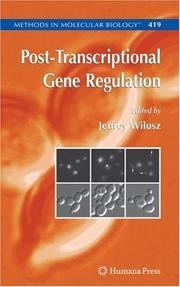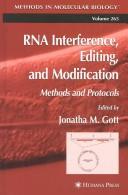| Listing 1 - 10 of 13 | << page >> |
Sort by
|
Book
Year: 2013 Publisher: Bruxelles: UCL. Faculté de pharmacie et des sciences biomédicales,
Abstract | Keywords | Export | Availability | Bookmark
 Loading...
Loading...Choose an application
- Reference Manager
- EndNote
- RefWorks (Direct export to RefWorks)
ln this work, we attempted to determine the function of SZRDl,a protein of unknown function using a multidimensional approach. Our selection of SZRDl was based on the presence of four putative binding sites for miR-128 in its 3'UTR.Mi-RNAs are small RNAs that inhibit translation and promote mRNA degradation of target transcripts. They usually have many targets, but effects on individual targets are often modest. Small changes in target transcripts are therefore thought to collaborate to lead to a cellular function. We therefore hypothesized that uncharacterized targets of a mi-RNA might functionally collaborate with other targets of the same mi-RNA. To test this hypothesis we focused on miR-128 and one of its predicted targets of unknown function, SZRDl. MiR-128 targets are implicated in cellular signaling pathways and in a RNA quality control mechanism called Nonsense-Mediated Decay (NMD). we hypothesized that SZRDl could be implicated in the function’s exerted by miR-128.First, we demonstrated that the conserved multiple binding site of miR-128 in the 3'UTR of SZRDl are indeed functional using luciferase reporter genes.The analysis of SZRDl protein function followed a multidimensional approach based on primary sequence analysis, existing high-throughput data and identification of possible partners through tandem affinity purification followed by mass spectrometry:The SZRDl gene gives rise to several transcripts that code for proteins of 133 and 154 amino acids (SZRDl Long and SZRDl Short). We showed that SZRDl Long is excluded from the nuclei, possibly through a predicted nuclear export sequence (NES), and that SZRDl Short is phosphorylated in a cell cycle-dependent manner.We identified several proteins implicated in various aspects of RNA metabolism as interactors of SZRDl: RENTl/UPFl,STRAP, ClQBP, UNR/CSDEl and GEMIN2.We provide preliminary evidence that SZRDl might regulate the function of its interactors RENTl/UPFl and STRAP.Notably, RENTl/UPFl has previously been identified as a target of miR-128. Our data therefore are consistent with the hypothesisthat target genes of miR-128 functionally collaborate. Dans le cadre de ce mémoire, nous avons cherché à établir la fonction de SZRDl en utilisant une approche multidimensionelle. C'est la présence de quatre sites de liaisons potentiels au miR-128 dans la région 3'non traduite (3'UTR) de SZRDl qui a guidé notre choix vers cette protéine.Les mi-ARNs sont de courts ARNs simple brin qui inhibent la traduction et/ou favorisent la dégradation de leurs transcrits cibles. Dans la plupart des cas, chaque mi-ARN possède un grand nombre de cibles mais l'effet sur chacune d'entre elles est souvent modeste. Ilest donc possible que l'association de ces faibles mais nombreux changements ait une importance fonctionnelle. Nous avons donc émis l'hypothèse qu'une cible non caractérisée d'un mi-ARN pourraient collaborer avec d'autres cibles de ce même mi-ARN. Nous avons testé cette hypothèse en étudiant le miR-128 et une de ses cibles prédites mais dont la fonction est inconnue, SZRDl. Les cibles connues du miR-128 jouent un rôle dans la signalisation cellulaire et dans un mécanisme de contrôle de la qualité des ARNs appelé « Nonsense-Mediated Decay » ou NMD. Dès lors, nous avons émis l'hypothèse selon laquelle la protéine SZRDl pourrait être impliquée dans les fonctions connues de miR-128.Nous avons tout d'abord démontré, grâce à un test rapporteur luciférase, que les sites de liaisons conservés pour le miR-128 présents dans la région 3'UTR de SZRDl sont fonctionnels et que SZRDl semble bien être une cible du miR-128. Afin de déterminer la fonction de SZRDl,nous avons utilisé une approche multidimensionnelle basée sur l'analyse de la séquence primaire en résidus aminés de la protéine, sur des données issues d'analyses à haut débit et sur l'identification de partenaires potentiels par purification d'affinité en tandem suivie de spectrométrie de masse :Le gène SZRDl donne lieu à plusieurs transcrits codants pour des protéines de 133 et 154 résidus aminés (SZRDl Courte et SZRDl Longue, respectivement) . Nous avons montré que SZRDl Longue peut être exclue du noyau, probablement dû à la présence d'une séquence d'export nucléaire (NES) et que SZRDl Courte est phosphorylée à certains stades du cycle cellulaire.Nous avons identifié plusieurs protéines interactantes de SZRDl qui sont impliquées à différents niveaux du métabolisme de I'ARN : RENTl/UPFl, STRAP, ClQBP, UNR/CSDl et GEMIN2.Nous avons obtenus des données préliminaires suggérant que SZRDl est capable de réguler,la fonction de certaines de ses protéines partenaires comme RENTl/UPFl et STRAP.Il est important de noter que RENTl/UPFl a également été décrit comme étant une cible du miR- 1Nos données sont donc en accord avec l'hypothèse selon laquelle les gènes cibles du miR- 128 collaborent fonctionnellement.
Dissertation
Year: 1988 Publisher: Amsterdam Rodopi
Abstract | Keywords | Export | Availability | Bookmark
 Loading...
Loading...Choose an application
- Reference Manager
- EndNote
- RefWorks (Direct export to RefWorks)
Cell Nucleus --- Nucleoside Deaminases --- RNA Precursors --- Adenosine Deaminase --- RNA Processing, Post-Transcriptional --- metabolism --- genetics --- metabolism --- genetics
Dissertation
Year: 1992 Publisher: Amsterdam Focus
Abstract | Keywords | Export | Availability | Bookmark
 Loading...
Loading...Choose an application
- Reference Manager
- EndNote
- RefWorks (Direct export to RefWorks)
Crithidia --- DNA, Mitochondrial --- RNA --- RNA Processing, Post-Transcriptional --- Gene Expression Regulation --- Transcription, Genetic --- RNA --- genetics --- chemistry --- chemistry --- genetics

ISBN: 354051774X Year: 1990 Publisher: Berlin New York Tokyo Springer
Abstract | Keywords | Export | Availability | Bookmark
 Loading...
Loading...Choose an application
- Reference Manager
- EndNote
- RefWorks (Direct export to RefWorks)

ISSN: 00766879 ISBN: 9780123741554 0123741556 9786611056971 1281056979 0080550916 Year: 2007 Volume: v. 425. Publisher: Amsterdam : Academic Press,
Abstract | Keywords | Export | Availability | Bookmark
 Loading...
Loading...Choose an application
- Reference Manager
- EndNote
- RefWorks (Direct export to RefWorks)
The presence of modified nucleotides in cellular RNAs has been known for decades and over 100 distinct RNA modifications have been characterized to date. While the exact role of many of these modifications is still unclear, many are highly conserved across evolution and most contribute to the overall fitness of the organism. In recent years, new methods and bioinformatics approaches have been developed for the dissection of modification pathways and functions. These methods intersect a number of related fields, ranging from RNA processing to comparative genomics and systems biology. In add
RNA editing. --- ARN --- Edition --- RNA Editing --- RNA Processing, Post-Transcriptional --- Metabolism --- Biochemical Processes --- Gene Expression Regulation --- Biochemical Phenomena --- Metabolic Phenomena --- Genetic Processes --- Chemical Processes --- Chemical Phenomena --- Genetic Phenomena --- Phenomena and Processes --- Editing, RNA --- Messenger RNA editing --- mRNA editing --- Genetic regulation
Book
ISBN: 9781587063299 Year: 2009 Publisher: Austin, Tex. : Landes Bioscience,
Abstract | Keywords | Export | Availability | Bookmark
 Loading...
Loading...Choose an application
- Reference Manager
- EndNote
- RefWorks (Direct export to RefWorks)
DNA Restriction-Modification Enzymes --- DNA Methylation --- DNA Restriction-Modification Enzymes --- Evolution, Molecular. --- RNA Processing, Post-Transcriptional --- Nucleic acids --- Nucleosidases. --- DNA --- Methyltransferases. --- Acides nucléiques --- Nucléosidases --- ADN --- Méthyltransférases --- physiology. --- physiology. --- ultrastructure. --- physiology. --- Metabolism. --- Methylation. --- Métabolisme --- Méthylation
Book
ISBN: 0128023317 0128021926 9780128021927 Year: 2015 Publisher: Amsterdam, [Netherlands] : Academic Press,
Abstract | Keywords | Export | Availability | Bookmark
 Loading...
Loading...Choose an application
- Reference Manager
- EndNote
- RefWorks (Direct export to RefWorks)
RNA Modification provides a useful examination of the science and its role in biological regulation, the current frontier of life science research, and includes various RNA modications and their role in gene expression. It represents the most up-to-date knowledge and protocols available today.
- Dynamic RNA modifications and their roles in biological regulation are the current frontier of life science research
- This volume of Methods in Enzymology represents up to date knowledge and protocols
RNA Processing, Post-Transcriptional --- Pseudouridine --- RNA, Transfer --- Gene Expression Regulation --- Uridine --- Biochemical Processes --- RNA --- Metabolism --- Genetic Processes --- Ribonucleosides --- Pyrimidine Nucleosides --- Biochemical Phenomena --- Chemical Processes --- Nucleic Acids --- Metabolic Phenomena --- Nucleosides --- Genetic Phenomena --- Nucleic Acids, Nucleotides, and Nucleosides --- Phenomena and Processes --- Chemical Phenomena --- Pyrimidines --- Chemicals and Drugs --- Heterocyclic Compounds, 1-Ring --- Heterocyclic Compounds --- Animal Biochemistry --- Human Anatomy & Physiology --- Health & Biological Sciences --- RNA editing. --- ARN --- pharmacokinetics --- Edition --- Editing, RNA --- Messenger RNA editing --- mRNA editing --- RNA Processing, Post-Transcriptional. --- pharmacokinetics. --- Genetic regulation
Book
ISBN: 9780323914246 9780323913058 0323914241 0323913059 Year: 2022 Publisher: Amsterdam, Netherlands : Elsevier,
Abstract | Keywords | Export | Availability | Bookmark
 Loading...
Loading...Choose an application
- Reference Manager
- EndNote
- RefWorks (Direct export to RefWorks)
Post-transcriptional Gene Regulation in Human Disease, a new volume in the Translational Epigenetics book series, offers a thorough overview and discussion of post-transcriptional genetic control mechanisms and their roles across various pathologies and human developmental outcomes, along with regulatory mechanisms targeted for therapeutic approaches. The book is broadly divided in two parts: early chapters describe the basics of post-transcriptional gene regulation, associated epigenetic mechanisms, the role of RNA binding proteins, the evolution of post-transcriptional gene regulation, and methods to study these mechanisms. The second half of the book includes deeper discussion of post-transcriptional gene regulation across specific diseases and therapeutics targets. Various post-transcriptional events, including alternative splicing and polyadenylation, mRNA stability, and miRNAs and their involvement in the disease progression, are examined in detail.
Genetic regulation. --- Genetic disorders. --- Congenital diseases --- Disorders, Genetic --- Disorders, Inherited --- Genetic diseases --- Hereditary diseases --- Inherited diseases --- Diseases --- Medical genetics --- Gene expression --- Gene expression regulation --- Gene regulation --- Biosynthesis --- Cellular control mechanisms --- Molecular genetics --- Regulation --- Genetic disorders --- Genetic regulation --- Diagnosis. --- Mathematical models. --- Genetic diagnosis --- Gene Expression Regulation --- Disease --- RNA Processing, Post-Transcriptional --- genetics

ISBN: 9781588297839 1588297837 1597450332 Year: 2008 Volume: 419 Publisher: Totowa, NJ : Humana Press : Imprint: Humana,
Abstract | Keywords | Export | Availability | Bookmark
 Loading...
Loading...Choose an application
- Reference Manager
- EndNote
- RefWorks (Direct export to RefWorks)
In Post-Transcriptional Gene Regulation, renowned authors present current technical approaches to most aspects of post-transcriptional control and provide a useful and versatile laboratory bench resource. With chapters split into sections covering bioinformatics, fundamental aspects of the study of RNA biology, and techniques for specific aspects of RNA biology, the expert authors have filled the book with invaluable tricks of the trade, perfected in their state-of-the-art laboratories. This new volume from the Methods in Molecular Biology series is convinently divided into three sections. The first section presents a series of bioinformatic approaches to address the use of RNA databases and algorithms to the study of post-transcriptional regulation involving untranslated regions of transcripts. In the second section, a series of methods applicable to fundamental issues in mRNA biology are presented. These include RNA structure/function, mRNP analysis and novel methods for mRNA labeling and isolation. The third section of this volume presents methodologies to study particular aspects of post-transcriptional control. This section includes methods for the study of alternative splicing and 3’ end processing, mRNA localization, mRNA translation, mRNA stability and si/miRNA regulation. Collectively, Post-Transcriptional Gene Regulation provides the reader with a useful and versatile laboratory bench resource that will become an essential reference in the field.
Genetic regulation --- Messenger RNA --- Cellular control mechanisms --- Bioinformatics --- Gene Expression Regulation --- RNA Processing, Post-Transcriptional --- Computational Biology --- Bioinformatics. --- Régulation génétique --- ARN messager --- Régulation cellulaire --- Bio-informatique --- Laboratory manuals --- Manuels de laboratoire --- Informational RNA --- Messenger ribonucleic acid --- mRNA --- Protein transcript --- Protein transcripts --- Template RNA --- Bio-informatics --- Biological informatics --- Biology --- Information science --- Computational biology --- Systems biology --- Data processing --- Cell regulation --- Biological control systems --- Cell metabolism --- RNA --- Gene expression --- Gene expression regulation --- Gene regulation --- Biosynthesis --- Molecular genetics --- Regulation --- Biochemistry. --- Cytology. --- Human genetics. --- Biochemistry, general. --- Cell Biology. --- Human Genetics. --- Cell biology --- Cellular biology --- Cells --- Cytologists --- Genetics --- Heredity, Human --- Human biology --- Physical anthropology --- Biological chemistry --- Chemical composition of organisms --- Organisms --- Physiological chemistry --- Chemistry --- Medical sciences --- Composition --- Genetic regulation - Laboratory manuals --- Messenger RNA - Laboratory manuals --- Cellular control mechanisms - Laboratory manuals --- Gene Expression Regulation - laboratory manuals --- RNA Processing, Post-Transcriptional - Laboratory Manuals

ISBN: 1588292428 1592597750 1280360267 9786610360260 Year: 2004 Volume: 265 Publisher: Totowa, NJ : Humana Press : Imprint: Humana,
Abstract | Keywords | Export | Availability | Bookmark
 Loading...
Loading...Choose an application
- Reference Manager
- EndNote
- RefWorks (Direct export to RefWorks)
The study of RNA interference, editing, and modification has led to major shifts in our understanding of how genes are expressed and regulated. In RNA Interference, Editing, and Modification: Methods and Protocols, hands-on experimentalists describe in detail the protocols and assays they have developed to study these processes in most of the major biological systems in which they are known to occur-a wide range of organisms that includes worms, flies, trypanosomes, mammals, and plants. A historical overview of each subject is provided to put related chapters into a larger context. RNA interference (RNAi) has also emerged in recent years as an important and promising tool for gene discovery and reverse genetic engineering. Application of this cutting-edge technique is described for a range of experimental systems. Topics of interest include stable and transient RNA interference, RNA editing, gene silencing, bioinformatics, small noncoding RNAs, and RNomics. Special attention is given to methods for the identification and characterization of small RNAs, many of which are involved in RNA interference or modification. In addition, techniques used to study RNA editing mechanisms are elaborated for both systems that involve the conversion of one base to another and insertion-deletion editing. To promote the adaptation of their assays and approaches for use in other biological systems, the authors have included a range of methods representative of the major experimental systems in a given field. All protocols presented follow the successful Methods in Molecular Biology™ series format, each one offering step-by-step laboratory instructions, an introduction outlining the principle behind the technique, lists of equipment and reagents, and tips on troubleshooting and avoiding known pitfalls. State-of-the-art and highly practical, RNA Interference, Editing, and Modification: Methods and Protocols offers not only geneticists, molecular biologists, and bioinformaticists a comprehensive collection of readily reproducible techniques for the elucidation of gene function and the alteration of gene expression, but also describes how best they may be productively used to address outstanding mechanistic questions and adapted to novel biological systems.
RNA Editing --- RNA Interference --- RNA editing --- ARN --- Laboratory manuals. --- Edition --- Manuels de laboratoire --- RNA editing -- Laboratory manuals. --- Laboratory Manuals --- Publication Formats --- RNA Processing, Post-Transcriptional --- Gene Silencing --- Epigenesis, Genetic --- Biochemical Processes --- Publication Characteristics --- Metabolism --- Gene Expression Regulation --- Genetic Processes --- Chemical Processes --- Metabolic Phenomena --- Biochemical Phenomena --- Genetic Phenomena --- Chemical Phenomena --- Phenomena and Processes --- Genetics --- Biology - General --- Biochemistry --- Biology --- Chemistry --- Health & Biological Sciences --- Physical Sciences & Mathematics --- Editing, RNA --- Messenger RNA editing --- mRNA editing --- Genetic regulation --- Biochemistry. --- Biochemistry, general. --- Biological chemistry --- Chemical composition of organisms --- Organisms --- Physiological chemistry --- Medical sciences --- Composition --- Genetic regulation. --- Genetic Phenomena. --- Rna editing --- Rna interference
| Listing 1 - 10 of 13 | << page >> |
Sort by
|

 Search
Search Feedback
Feedback About UniCat
About UniCat  Help
Help News
News